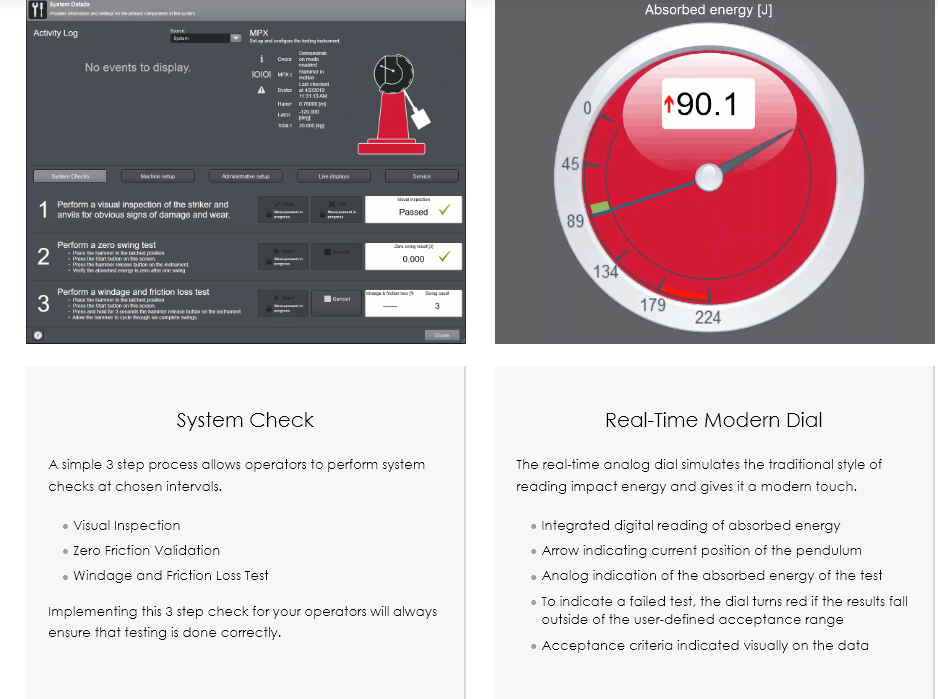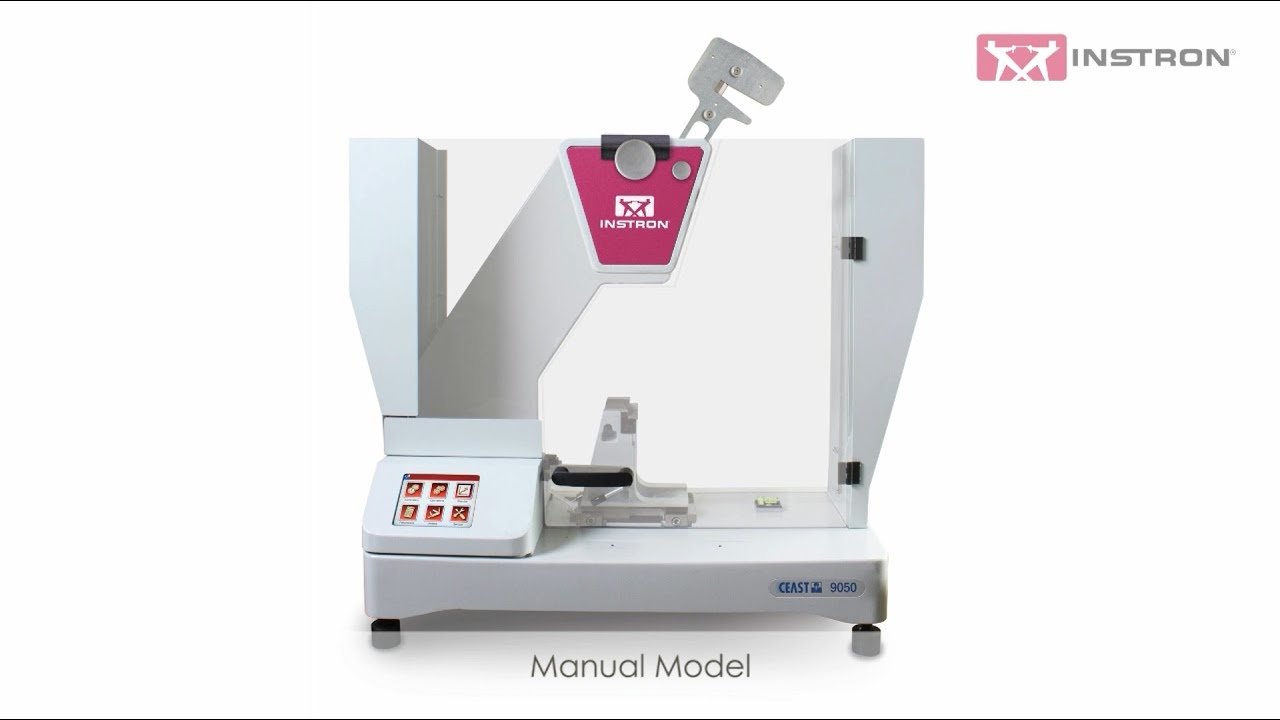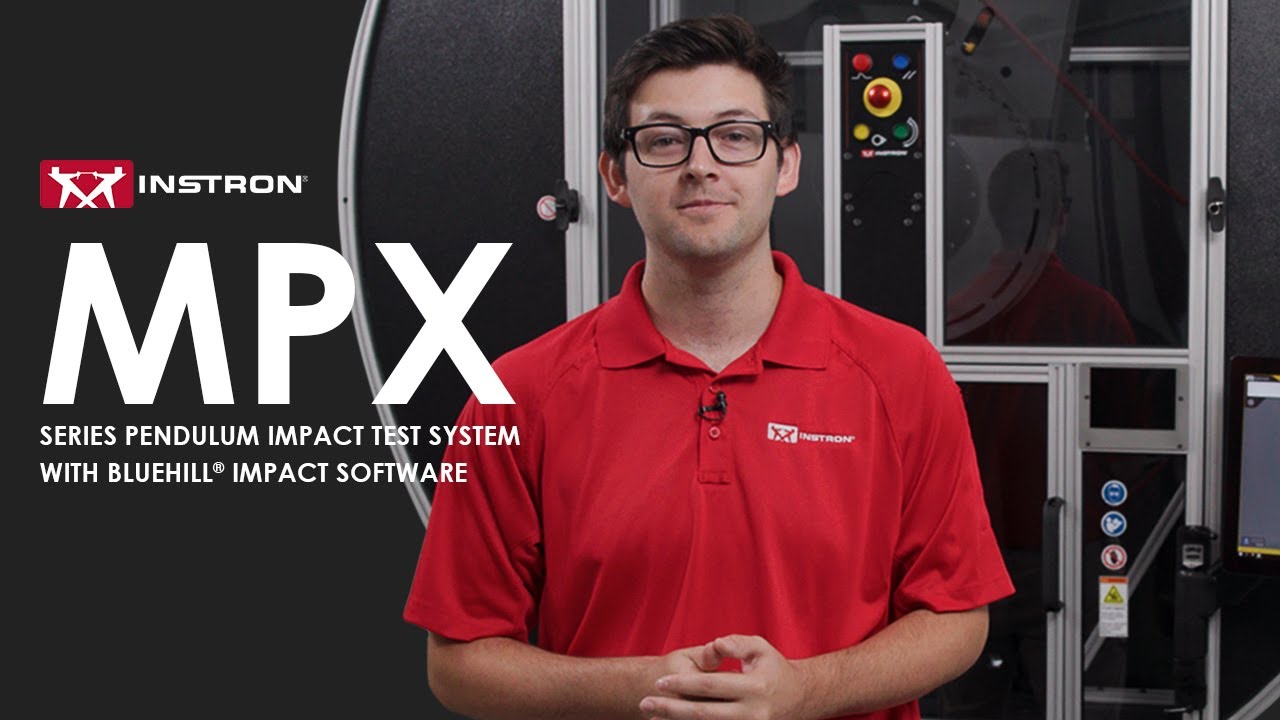Pendulum Impact Testing System
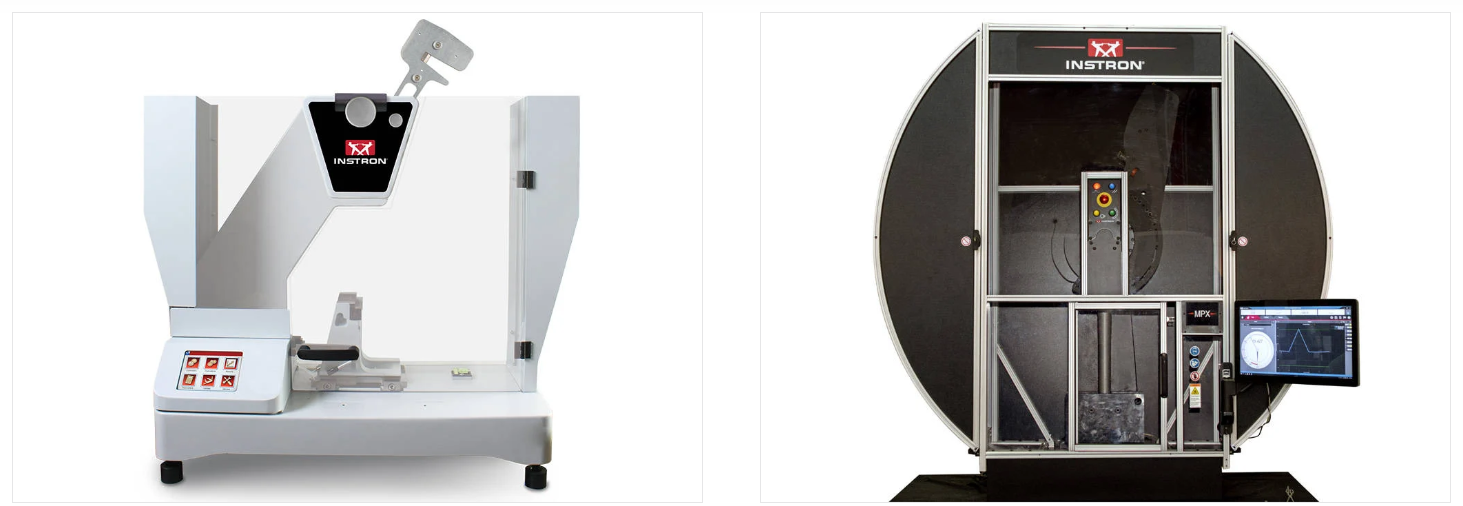
Pendulum impact testing is a critical method used to evaluate the toughness and impact resistance of materials. This type of testing simulates real-world impact conditions to determine how materials behave when subjected to sudden forces, such as shocks or blows. It is widely used across industries, including automotive, aerospace, construction, and packaging, to ensure the safety and performance of materials under fast pace loading.
Overview of Pendulum Impact Testing
Pendulum impact testing involves striking a test specimen with a pendulum hammer and measuring the energy absorbed by the specimen during fracture. This absorbed energy indicates the material's impact toughness or resistance to breaking under sudden force. The test setup typically includes a heavy pendulum attached to a frame, which swings to impact the specimen at a controlled velocity. The three most common types of pendulum impact tests are:
- Charpy Impact Test: The Charpy test involves striking a notched specimen placed horizontally on two supports. The test measures the energy absorbed by the specimen as it fractures at the notch. This test is commonly used for metals and other rigid materials to assess their toughness.
- Izod Impact Test: In the Izod test, a notched specimen is mounted vertically in a vise, with the notch facing the pendulum hammer. The energy absorbed by the specimen as it breaks is measured, providing insights into the material's brittleness or ductility.
- Tensile Impact Test: Unlike the Charpy and Izod tests, which involve bending, the tensile impact test evaluates the impact resistance of materials in a tensile loading mode. This test is particularly useful for evaluating plastics and composites, where tensile failure modes are critical.
International Standards for Pendulum Impact Testing
1. ISO 148-1: Charpy Pendulum Impact Test (Metallic Materials)
- Purpose: ISO 148-1 specifies the method for conducting Charpy impact tests on metallic materials. It outlines the dimensions of the test specimens, the notching procedures, and the required specifications for the pendulum impact testing machine.
- Key Aspects:
- Standard specimen dimensions: Typically 55 mm in length, 10 mm square cross-section, with a 2 mm deep notch.
- Test temperature considerations: The standard provides guidance on testing at various temperatures to assess the material’s impact toughness under different conditions.
- Reporting requirements: Includes details on how to report absorbed energy, fracture appearance, and lateral expansion measurements.
2. ASTM E23: Standard Test Methods for Notched Bar Impact Testing of Metallic Materials
- Purpose: ASTM E23 provides the guidelines for conducting Charpy and Izod impact tests on metallic specimens. This standard is widely used in the United States and specifies requirements for specimen preparation, testing conditions, and machine calibration.
- Key Aspects:
- Equipment calibration: Ensures that the pendulum impact tester is properly calibrated for accurate energy measurements.
- Notch types: Describes the different notch configurations, such as V-notch and U-notch, and their implications for test results.
- Fracture analysis: Specifies the procedures for examining and classifying fractures to assess material behavior.
3. ISO 179-1: Plastics – Determination of Charpy Impact Properties
- Purpose: ISO 179-1 is focused on the Charpy impact testing of plastics and other non-metallic materials. This standard details the test procedures, specimen dimensions, and impact conditions specific to plastics.
- Key Aspects:
- Different testing configurations: Includes methods for testing with edgewise, flatwise, and endwise specimens.
- Test temperature: Addresses how to account for temperature variations when testing plastics, which can significantly affect impact properties.
- Reporting: Specifies how to report the absorbed energy per unit width and any other relevant fracture characteristics.
4. ISO 180: Plastics – Determination of Izod Impact Strength
- Purpose: ISO 180 provides guidelines for conducting Izod impact tests on plastics, describing the test method, specimen preparation, and impact conditions.
- Key Aspects:
- Specimen dimensions and notch types: Specifies the requirements for the notching process and the dimensions of the test specimens.
- Test conditions: Covers aspects such as the pendulum speed and the energy range of the impact testing machine.
- Data interpretation: Outlines how to calculate and report impact strength, including considerations for material thickness and test temperature.
5. ASTM D256: Standard Test Methods for Determining the Izod Pendulum Impact Resistance of Plastics
- Purpose: ASTM D256 specifies the methods for conducting Izod impact tests on plastics. It provides detailed instructions on specimen preparation, testing procedures, and impact conditions tailored to plastic materials.
- Key Aspects:
- Testing conditions: Describes the pendulum’s velocity, energy ranges, and the test environment, which are critical for reliable results.
- Notching: Highlights the importance of accurate notch preparation, which significantly affects the impact results.
- Data reporting: Specifies how to report impact energy absorbed and the classification of fracture types.
6. ISO 8256: Plastics – Determination of Tensile-Impact Strength
- Purpose: ISO 8256 focuses on the tensile impact testing of plastics, which assesses the material’s toughness when subjected to tensile forces during impact.
- Key Aspects:
- Specimen orientation: Specifies the positioning of the specimen to ensure consistent tensile loading during the impact.
- Test setup: Includes guidance on the mounting of specimens, the pendulum velocity, and the clamping conditions to ensure that the impact force is applied correctly.
- Data interpretation: Provides methods for calculating tensile impact strength, taking into account the width, thickness, and fracture behavior of the specimen.
Key Elements of Pendulum Impact Testing
- Specimen Preparation: Specimen geometry, surface finish, and notching are crucial for ensuring consistent results. International standards provide detailed guidance on specimen dimensions, notch type, and preparation methods to minimize variability.
- Machine Calibration and Setup: Proper calibration of the pendulum impact testing machine is essential to ensure accurate measurements. Calibration includes verifying the pendulum arm length, impact velocity, and energy measurement system according to standard requirements.
- Test Execution: During testing, the pendulum swings down to strike the specimen, and the energy absorbed by the specimen is measured. The standards specify the permissible deviations in swing angle, impact speed, and environmental conditions.
- Data Analysis and Reporting: After testing, data analysis involves calculating the absorbed energy, examining fracture surfaces, and determining fracture toughness. The results are reported according to the guidelines set by the relevant international standard, providing consistent metrics for material comparison.
Instron's Low Range Pendulum Impact Tester - 9050
The Instron CEAST 9050 Impact Pendulum is designed to accurately measure the impact resilience of plastics and composites, providing reliable results easily and safely. This versatile system is fully compliant with key ISO and ASTM impact testing standards, supporting a wide range of tests including Charpy, Izod, and Tensile Impact. The CEAST 9050 covers an extensive energy range from 0.5 to 50J, making it suitable for evaluating the toughness and impact resistance of various materials. With its advanced safety features, precise measurement capabilities, and adherence to international testing methods, the CEAST 9050 is an essential tool for laboratories focused on material performance and quality control.
- High-Precision Energy Measurement:The 9050 Impact Tester features advanced instrumentation capable of measuring impact energy with high precision and accuracy. Its energy measurement system uses high-resolution optical encoders and feedback loops in the instrumented mode to provide consistent and reliable results, crucial for research and quality control.
- Wide Range of Testing Capabilities:The 9050 is designed to accommodate a variety of impact tests, including Charpy, Izod, and tensile impact testing, with the flexibility to test different materials and specimen sizes. The system’s interchangeable hammer and anvil configurations allow for quick adaptation to different testing standards and specimen geometries.
- Compliance with International Standards:Instron’s 9050 Impact Tester is compliant with a wide range of international standards, including ASTM D256 (Izod testing for plastics), ISO 179 (Charpy testing for plastics), ISO 180 (Izod testing for plastics), ASTM E23 (Charpy and Izod testing for metals), and ISO 8256 (tensile impact testing). This ensures that test results are consistent and comparable across different laboratories and industries.
- User-Friendly Software Interface:The 9050 Impact Tester is equipped with Instron’s intuitive Bluehill® Impact software, which provides a user-friendly interface for setting up tests, analyzing data, and generating detailed reports. The software includes pre-configured test methods compliant with various standards, making it easy to get started with testing.
- Specimen Handling and Alignment: Accurate specimen alignment is critical for reliable impact testing results. The 9050 Impact Tester includes features such as automatic feeder and special specimen centering and alignment tools, reducing human error and enhancing test repeatability. Optional accessories like automated specimen feeding systems further improve throughput in high-volume testing environments.
- Robust Safety Features:Safety is paramount when conducting impact tests due to the high kinetic energies involved. The 9050 is equipped with safety enclosures, interlocks, and emergency stop functions to protect operators from potential hazards during testing. The design ensures that testing can be conducted safely even in high-energy applications.
- Modular Design and Customization Options:The modular design of the 9050 allows for easy customization and upgrading of components. Users can select from various hammer weights, pendulum sizes, and specimen fixtures to tailor the system to their specific testing needs. This flexibility makes the 9050 adaptable to both current and future testing requirements.

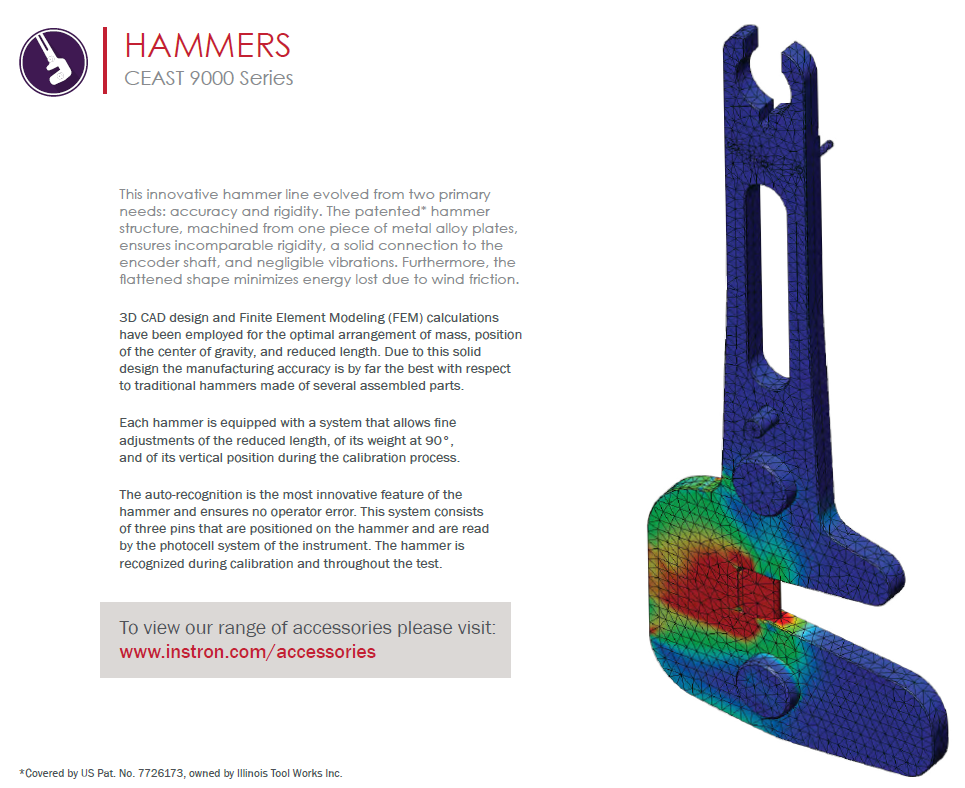
Instron's CEAST 9050 Pendulum Impact Tester Includes two models the Manual and Automatic models, both models have the following features:
- Monolithic cast iron frame
- Intuitive touch panel operation
- Automatic hammer identification and verification
- Angular encoder measuring to 0.05° resolution
- Quick-change hammers andspecimen supports
- Hammer disc brake system
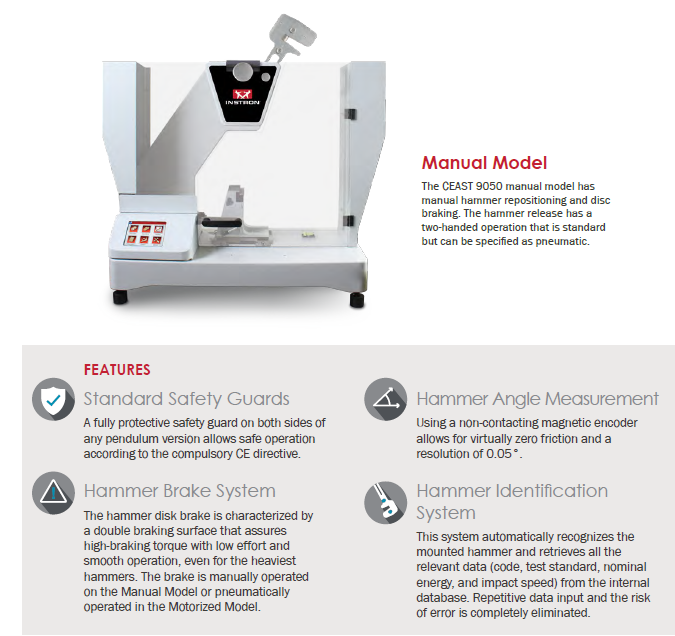

For the higher range of energy an MPX pendulum Impact Tester can be used.
Instron's Pendulum Impact Industrial Series the MPX
The Instron MPX Motorized Pendulum Impact Test System, equipped with the advanced Bluehill Impact software, is the preferred solution for metals impact testing to Charpy and Izod standards. With capacities ranging from 300 to 900 Joules, the MPX is designed for high-efficiency, high-volume testing, offering ease of operation and exceptional performance. The system features a fully enclosed testing space with an integrated guard and safety control system that meets stringent European CE mark requirements and ISO 13849 standards, ensuring outstanding protection for operators. This combination of advanced safety, reliability, and user-friendly operation makes the MPX an ideal choice for demanding impact testing applications.
The Instron MPX Motorized Pendulum Impact Test System is engineered to deliver precision, safety, and efficiency in metals impact testing. With a range of advanced features and benefits, the MPX stands out as an ideal solution for high-volume testing environments where adherence to international standards and operator safety are paramount. Here’s an in-depth look at the key features and benefits of the MPX system:
Features and Benefits
- Standard Capacities from 300 to 900 Joules: The MPX system is available in standard capacities of 300, 450, 600, 750, and 900 Joules, allowing laboratories to select the appropriate capacity for their testing needs. This flexibility makes the MPX suitable for testing a wide range of metals, from softer materials like aluminum alloys to tougher steels and other high-strength metals.
- Automatic Test Start at Door Closure: For increased efficiency, the MPX automatically initiates the test when the safety doors are closed. This feature streamlines the testing process, especially in high-throughput environments, and is essential for testing non-ambient specimens where time is a critical factor. It ensures adherence to testing standards while enhancing workflow productivity.
- Optional Interchangeable Hammer Weights: The MPX offers optional interchangeable hammer weights that allow users to adjust the system’s impact capacity easily without removing the hammer shaft. This versatility reduces downtime, as operators can quickly reconfigure the system for different test requirements, enhancing the overall testing efficiency and expanding the range of materials that can be tested on a single machine.
- Motorized Hammer Lift and Automatic Return: The motorized hammer lift and automatic return to the start position streamline the testing cycle, minimizing manual intervention. This automated functionality not only increases productivity but also improves operator safety by reducing the physical handling of heavy components, which can be a hazard in traditional impact testing systems.
- Quick-Response Hammer Brake, Clutch, and Latch Mechanisms: The MPX system features quick-response hammer brake, clutch, and latch mechanisms that allow for rapid operation. These components ensure the hammer is securely held in place until the test is initiated and can quickly reset for the next test, enhancing testing speed and overall system efficiency.
- Safety Enclosure with Interlocks: The system’s fully enclosed design with interlocks prevents the hammer from releasing when the doors are open, significantly enhancing operator safety. This robust safety feature is essential in high-energy impact testing, protecting operators from accidental hammer release and ensuring compliance with stringent safety standards.
- Adjustable Latch Height for Lower Energies and Velocities: The adjustable latch height feature provides configurability to conduct tests at lower energies and velocities, accommodating materials that require testing under less severe impact conditions. This flexibility allows the MPX system to handle a broader range of testing applications without compromising on accuracy or safety.
- Standard Base Design Meets ASTM and ISO Recommendations: The MPX is built with a standard base design that meets both ASTM and ISO recommendations, ensuring compliance with global impact testing standards. This adherence to standardized design principles guarantees that the system is compatible with existing testing protocols and provides results that are reliable and comparable across different laboratories.
- Selectable Charpy Anvil Inserts and Striker Options:The MPX offers selectable Charpy anvil inserts and striker options to meet a variety of international test standards. This customization ensures that the system can be tailored to specific test requirements, providing the precision needed to achieve accurate, repeatable results for various materials and testing conditions.
- Compliance with Multiple International Standards:The MPX is designed to meet a comprehensive range of impact testing standards, including ASTM E23, ISO 148, EN 10045, GOST 9454, AS 1544, JIS Z 2242, and JIS B 7722. This broad compliance ensures that the MPX can be used in laboratories worldwide, providing consistent and standard-compliant testing for global markets.
Powerful New Software for Impact Testing: Bluehill Impact
Built on the foundation of Instron's popular and adaptive Bluehill platform, Bluehill Impact is the company’s newest and most powerful software solution for impact testing. Designed specifically for touch interaction, Bluehill Impact features a meticulously crafted visual interface with large touchpoints and intuitive gestures, making the user experience simpler and smarter than ever before. This software not only enhances the power and flexibility found in previous versions of Instron’s impact testing software but also introduces a host of advanced capabilities.
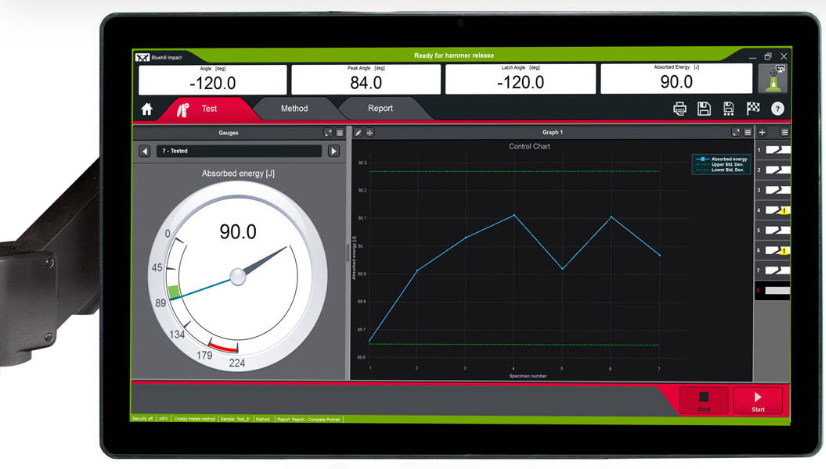
Key Features of Bluehill Impact
- Pre-Loaded Test Methods:Bluehill Impact comes with a variety of pre-loaded test methods that comply with international standards, allowing users to quickly set up and execute tests without the need for extensive configuration. This feature streamlines the testing process, saving valuable time and reducing the potential for user error.
- Real-Time Analog Dials with Digital Data:The software offers real-time analog dials that provide immediate visual feedback during testing, accompanied by digital data for precise measurement. This dual display helps operators monitor test parameters effectively, ensuring that they can respond quickly to any deviations or anomalies.
- Enhanced Reporting and Data Exporting:Bluehill Impact includes advanced reporting capabilities, enabling users to generate detailed reports that capture critical testing data and observations. The software also supports easy data exporting, allowing users to share results with colleagues or integrate them into larger data analysis workflows.
Test Screen Functionality
The test screen is a key component of Bluehill Impact, featuring a simple control chart that can be easily configured to display various statistical metrics, such as standard deviation, averages, and acceptance ranges. This configurable control chart allows operators to monitor the performance of their materials in real time, providing essential insights into material behavior and consistency.
